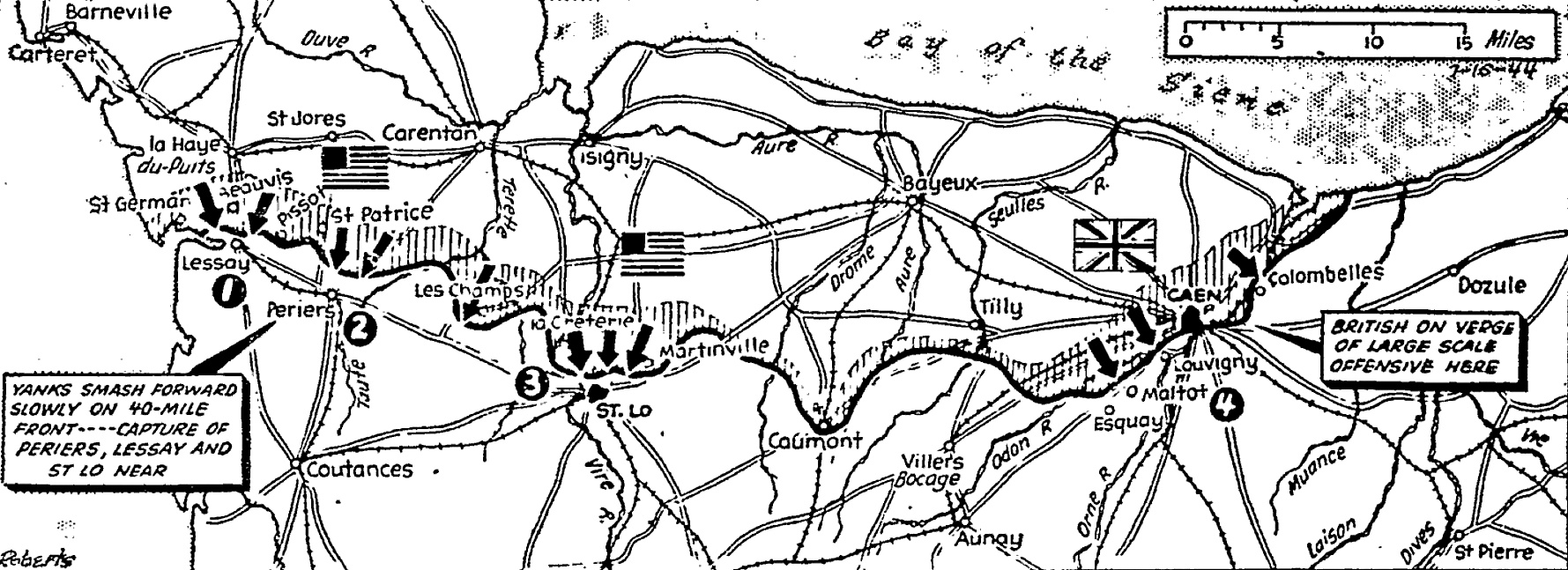The Pittsburgh Press (July 15, 1944)
YANKS STORM HINGE OF NAZI LINE
U.S. capture of three bastions in France near
Americans reach outskirts of Lessay
By Virgil Pinkley, United Press staff writer
Americans force ahead on the western end of the Normandy front, closing in on the Nazi bastions of Saint-Lô, Périers and Lessay, while on the eastern flank of the front, the British abandoned Maltot, below Caen.
SHAEF, London, England –
U.S. troops stormed today into the outskirts of Lessay, western anchor of a 40-mile German defense line in Normandy, closed against its central hinge at Périers, and gained nearly half a mile in a new drive against Saint-Lô at its eastern end.
The frontal assaults on the three key bastions of the German fortifications facing the Americans posed a direct threat to all of them, and official reports indicated they were “almost in the bag.”
Supreme Headquarters reported the capture of nine major German strongpoints on the approaches to Lessay and Périers, while field dispatches said the renewed assault on Saint-Lô had carried to Martinsville, a village a mile from the rubble-strewn citadel.
Bend back coastal end
U.S. assault units bending back the coastal end of the German line advanced about a mile on a four-mile front, overran five outlying villages, seized the entire north bank of the Ay River from the sea inland beyond Lessay, and hit the edge of the town itself.
At the center of the American front, other assault forces moved forward up to two and a half miles on a four-mile line, seizing four fortified villages and stabbing within two miles of Périers.
A headquarters spokesman said a fierce battle was raging for Saint-Lô. The latest dispatches from that sector said the Americans were battering in from the east, northeast and northwest.
British prepare drive
A “very large-scale German attack” was reported officially pending at the now-quiet British end of the French front, in which Sir Bernard L. Montgomery hoped to inflict another telling defeat on the enemy. Details were lacking.
The weather over Normandy was described officially as probably the worst since D-Day, with intermittent drizzles and dense fog virtually stopping air operations.
An estimated 100,000 German troops and tankmen were arrayed along the American front. They were giving ground slowly but steadily, and faced the threat of precipitate withdrawal to more solid defenses if their three keystone bases topple under the 1st Army onslaught.
Drive along river bank
Lacking details of the new drive against Saint-Lô as reported from the front, headquarters said, however, that “strong action” had been started to capture the town.
The American left wing reached Lessay along the north bank of the Ay River and captured the neighboring villages of Fererville (one mile to the west-northwest), Saint-Opportune (just north of the town) and Renneville, Laquerie and Pissot in a cluster on its approaches.
Overrun in the approach to Périers were Haut Perray, La Commune and Nay, along the road from Saint-Jores, as well as Saint-Patrice-de-Claids, two miles north of the Saint-Lô–Lessay highway.
The eastern half of the front remained static except for heavy artillery fire, especially around Maltot and the Canadian salient southwest of Caen. Headquarters disclosed last night that the British had pulled back from both Maltot and Hill 112 and that both now were in “no man’s land.”
Gen. Bradley ordered his troops forward in the Saint-Lô, Périers and Lessay sectors shortly before noon yesterday and by early evening they had advanced everywhere despite increased enemy artillery and mortar fire and heavy terrain obstacles.
Gain to northeast
“Very substantial gains” were reported easy and northeast of Saint-Lô, with the Americans gaining positions from which to mount the final assault on the city. La Creterie, three miles north-northwest of Saint-Lô, was also seized, with other forces consolidated their hold on newly-won terrain northwest and southeast of the city.
Halfway between Saint-Lô and Périers, the Americans drove a mile south from Les Champs-de-Losque to within a mile of the Saint-Lô–Lessay highway, backbone of the enemy’s defense line.
Effect junction
Two U.S. columns advancing around the eastern and western rim of the Marais de Gorges inundations due north of Périers effected a junction in advances of up to 3½ miles to within two miles of Périers itself.
The linkup of the two forces cleared the Germans from six square miles of marshland and put the Americans on more maneuverable terrain that should speed their advance southward.
Drive down road
Thrusting down the La Haye-du-Puits–Lessay road in frontal attacks, the Americans were less than a mile north of Lessay after capturing Beauvais. Coastal patrols west of Lessay advanced through Saint-Germain-sur-Ay against light opposition to Les Mézières.
Gen. Dwight D. Eisenhower’s communiqué said:
A few miles further east, we have taken Lalonde and have reached the flooded basin of the Ay River.

